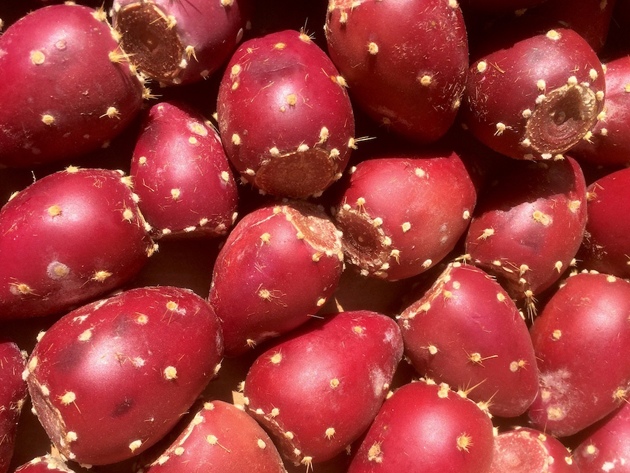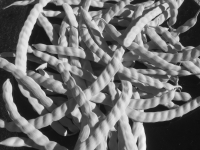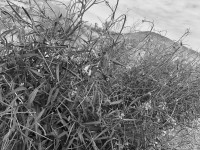Prickly Pear and Nopales

JULY INGREDIENT: PRICKLY PEAR AND NOPALES
We’re ending the second season of HDTK with a true crowd pleaser pairing: Prickly Pear and Nopales! Although these juicy, versatile, colorful, flavorful, festive plants are the icon of the desert, in actuality they’re rare punctuation marks breaking up the monotonous aisles of creosote and scrub. Nopales and prickly pear fruits belong to the opuntia genus, easily recognized as the cartoonish branching flat pads with exaggerated spines and bulbous nuggets dolloped on top—the subtly sweet and overwhelmingly succulent prickly pear fruits or “tunas” begin to ripen from green to magenta in mid-summer. The native opuntia in our region is the blueish-hued o. basilaris, or beavertail, the low-growing cluster you probably remember from its spectacular pink blooms that winked at us momentarily this dry spring. (Please don’t harvest these, or any other wild cacti, as they’re all protected by law.) Not to be a naysayer, because the entire cactus family is generally safe for culinary experimentation…just make sure you have a true cactus, as not all succulents are automatically edible. And as tempting as it is, don’t use your hands to grab them. They’re covered in microscopic hairs that painfully embed themselves in your skin and you’ll waste a lot of time getting them out. These are well-documented foods and I posted information on how to collect/de-spine on my website, so I won’t repeat that here.
Back to being a naysayer. If you do choose to work with either/both the pads or fruits, please be mindful of where you collect; cacti provide an invaluable source of water for desert critters during a critical time where little moisture can be found. I suggest purchasing the pads (check Kasa market or Stater Bros.) and the fruits if you can find them. Bonus for buying: the pads growing in your neighbor’s manicured yard are probably not the most palatable variety…you’ll definitely have a more satisfying product if you drop a buck or two. Sometimes you gotta spend money to make good food.
As we close out the second year of the test kitchen, I want to thank everyone who’s been a part of this project—from the people at HDTS to the folks at Copper Mountain Mesa Community Center to the hundreds of people who have shown up on the third Monday with hungry minds. Hope to catch you at this final celebration of the season! —Sarah Witt
For more information on HDTK, as well as more information on prickly pear/nopales, tips on how to identify them, and other nuggets of info, check out Sarah’s website.
Monday, July 16th at 7pm
Copper Mountain Mesa Community Center
65336 Winters Rd. Joshua Tree, CA
High Desert Test Kitchen (HDTK) is an informal monthly dinner gathering organized by artist Sarah Witt. Participants bring a dish to share that is either made with or inspired by ingredients inhabiting this peculiar span of the North American desert. Exploring the Mojave from a culinary perspective, HDTK naturally intersects with foraging practices and Native American traditions, and inevitably ignites debates concerning ethical human-to-wilderness relationships - hopefully challenging our taste buds too.
From September 2016 to July 2018 Sarah Witt organized High Desert Test Kitchen (HDTK), a monthly dinner gathering at the Copper Mountain Mesa Community Center in North Joshua Tree. Each month a different ingredient was featured with the challenge of incorporating local desert roots, fruits, insects, or a handful of twigs into a culinary repertoire. Participants would bring a dish to share, gathering together to discuss where the ingredients were sourced, the manner in which they were processed, and to consider their EQ (or edibility quotient). To read more about these native ingredients visit Sarah’s website.


















